Study Area Map Generator: A Web-Based Shiny Application for Generating Country-Level Study Area Maps for Scientific Publications
Abstract
1. Introduction
2. Methods and Software Description
2.1. Software Architecture and Workflow
- Frontend UI Layer: The interface is developed using Shiny for Python version 3.10, a web framework that supports reactive, browser-based applications. Key input controls include:
- ○
- A dropdown menu for country selection.
- ○
- A text input for custom map titles.
- ○
- A search box for city or place name using OpenStreetMap’s geocoding service.
- ○
- A numeric input for zoom radius (in decimal degrees).
- ○
- Radio buttons for inset position (top or bottom right).
- ○
- A selection box for basemap choice, including OpenStreetMap and Google Satellite (Hybrid).
- Data Input and Geolocation Module:
- Map Rendering Engine:The application generates static maps using Cartopy (v0.22) and Matplotlib (v3.8), overlaid with:
- ○
- The selected basemap (either OpenStreetMap tiles or Google Hybrid Satellite imagery via mt1.google.com);
- ○
- Administrative boundaries, coastlines, and labels;
- ○
- A north arrow and scale bar, generated dynamically relative to the bounding box;
- ○
- An optional inset map that highlights the country or city within its continental context.
- Logic and Control Layer:The application adjusts zoom levels based on the bounding box dimensions. For instance:
- ○
- Countries with widths or heights > 20° default to zoom level 5;
- ○
- Extents > 40° default to zoom level 4;
- ○
- Bounding boxes are padded using the user-defined zoom radius for optimal framing.
- Export and Output Module:
- Deployment and Repository:
- ○
- app.py (that includes user interface definition, server logic, map rendering and helper functions).
- ○
- requirements.txt (Python package dependencies).
- ○
- Sample output images and usage instructions in the README.md.
- ○
- World administrative boundaries in geojson format.
2.2. Usability Survey
3. Results
3.1. App Functionalities
- Opens the app in the browser.
- Selects “Ecuador” from the dropdown list.
- Writes a custom map title, such as “Figure 1 Study Area in Ecuador”.
- Chooses whether the inset should appear in the upper or bottom right.
- Clicks “Generate Map”.
- The resulting map is displayed directly on the page with the customized elements.
3.2. Survey Results Analysis
4. Discussion
- Enables rapid and automated generation of consistent, publication-ready maps;
- Reduces time and technical barriers for users without GIS expertise;
- Ensures esthetic and functional map quality suitable for scientific journals;
- Is openly available and adaptable to subnational or multi-country analyses;
- Can be embedded into teaching materials, research workflows, and science communication platforms.
Limitations
5. Conclusions
Author Contributions
Funding
Informed Consent Statement
Data Availability Statement
Acknowledgments
Conflicts of Interest
Abbreviations
| GIS | Geographic Information System |
| FAIR | Findable, Accessible, Interoperable, and Reusable |
| ANOVA | Analysis Of Variance |
References
- Yang, J.; Huang, X. 30 m annual land cover and its dynamics in China from 1990 to 2019. Earth Syst. Sci. Data Discuss. 2021, 13, 1–29. [Google Scholar]
- Karra, K.; Kontgis, C.; Statman-Weil, Z.; Mazzariello, J.C.; Mathis, M.; Brumby, S.P. Global land use/land cover with Sentinel 2 and deep learning. In Proceedings of the 2021 IEEE International Geoscience and Remote Sensing Symposium IGARSS, Brussels, Belgium, 11–16 July 2021; IEEE: Piscataway, NJ, USA, 2021; pp. 4704–4707. [Google Scholar]
- Jia, J.S.; Lu, X.; Yuan, Y.; Xu, G.; Jia, J.; Christakis, N.A. Population flow drives spatio-temporal distribution of COVID-19 in China. Nature 2020, 582, 389–394. [Google Scholar] [CrossRef] [PubMed]
- Alvarez-Mendoza, C.I.; Teodoro, A.; Freitas, A.; Fonseca, J. Spatial estimation of chronic respiratory diseases based on machine learning procedures—An approach using remote sensing data and environmental variables in Quito, Ecuador. Appl. Geogr. 2020, 123, 102273. [Google Scholar] [CrossRef]
- Venter, Z.S.; Brousse, O.; Esau, I.; Meier, F. Hyperlocal mapping of urban air temperature using remote sensing and crowdsourced weather data. Remote Sens. Environ. 2020, 242, 111791. [Google Scholar] [CrossRef]
- Viera-Torres, M.; Sinde-González, I.; Gil-Docampo, M.; Bravo-Yandún, V.; Toulkeridis, T. Generating the baseline in the early detection of bud rot and red ring disease in oil palms by geospatial technologies. Remote Sens. 2020, 12, 3229. [Google Scholar] [CrossRef]
- Alvarez-Mendoza, C.I.; Guzman, D.; Casas, J.; Bastidas, M.; Polanco, J.; Valencia-Ortiz, M.; Montenegro, F.; Arango, J.; Ishitani, M.; Selvaraj, M.G. Predictive modeling of above-ground biomass in brachiaria pastures from satellite and UAV imagery using machine learning approaches. Remote Sens. 2022, 14, 5870. [Google Scholar] [CrossRef]
- Harrower, M.; Brewer, C.A. ColorBrewer.org: An online tool for selecting colour schemes for maps. Cartogr. J. 2003, 40, 27–37. [Google Scholar] [CrossRef]
- Salgado, L.; González, L.M.; Gallego, J.L.R.; López-Sánchez, C.A.; Colina, A.; Forján, R. Mapping Soil Organic Carbon in Degraded Ecosystems Through Upscaled Multispectral Unmanned Aerial Vehicle–Satellite Imagery. Land 2025, 14, 377. [Google Scholar] [CrossRef]
- QGIS Development Team. QGIS Geographic Information System, version 3.34; Open Source Geospatial Foundation Project: Chicago, IL, USA, 2025.
- Esri. ArcGIS Pro [Software de Sistema de Información Geográfica], versión 3.5; Environmental Systems Research Institute: Redlands, CA, USA, 2025. Available online: https://www.esri.com (accessed on 23 July 2025).
- Kraak, M. Cartographic principles. In Web Cartography; Taylor & Francis: London, UK, 2001; pp. 53–71. [Google Scholar]
- Heidari, N.; Schwippert, K.; Sprenger, S. Thinking. Speaking. Producing. Maps: Linking cartographic concepts and cartography-specific language use. Int. Res. Geogr. Environ. Educ. 2024, 1–23. [Google Scholar] [CrossRef]
- Lamprecht, A.L.; Garcia, L.; Kuzak, M.; Martinez, C.; Arcila, R.; Martin Del Pico, E.; Del Angel, V.D.; van de Sandt, S.; Ison, J.; Martinez, P.A.; et al. Towards FAIR principles for research software. Data Sci. 2020, 3, 37–59. [Google Scholar] [CrossRef]
- Kush, R.D.; Warzel, D.; Kush, M.A.; Sherman, A.; Navarro, E.A.; Fitzmartin, R.; Pétavy, F.; Galvez, J.; Becnel, L.; Zhou, F.; et al. FAIR data sharing: The roles of common data elements and harmonization. J. Biomed. Inform. 2020, 107, 103421. [Google Scholar] [CrossRef]
- Nivala, A.M.; Sarjakoski, L.T.; Sarjakoski, T. Usability methods’ familiarity among map application developers. Int. J. Hum.-Comput. Stud. 2007, 65, 784–795. [Google Scholar] [CrossRef]
- Norheim, R.A. Cartographic standards and practice in academic journals. In Proceedings of the ESRI International User Conference, San Diego, CA, USA, 23–27 July 2012; pp. 21–25. [Google Scholar]
- Ziemann, M.; Poulain, P.; Bora, A. The five pillars of computational reproducibility: Bioinformatics and beyond. Brief. Bioinform. 2023, 24, bbad375. [Google Scholar] [CrossRef] [PubMed]
- Posit, P.B.C. Shiny for Python [Software], version 0.6.2; Posit, PBC: Boston, MA, USA, 2023. Available online: https://shiny.posit.co/py (accessed on 23 July 2025).
- McNamara, A. Building Maps on the Web Using RStudio, Leaflet, & Shiny. In Proceedings of the ACM SIGGRAPH 2023 Labs, Los Angeles, CA, USA, 6–10 August 2023; pp. 1–2. [Google Scholar]
- Jordahl, K.; den Bossche, J.V.; Fleischmann, M.; Wasserman, J.; McBride, J.; Gerard, J.; Tratner, J.; Perry, M.; Garcia Badaracco, A.; Farmer, C.; et al. GeoPandas: Python Tools for Geographic Data [Software]; GeoPandas Development Team: Austin, TX, USA, 2024; Available online: https://geopandas.org (accessed on 23 July 2025).
- Met Office. Cartopy: A Cartographic Python Library with Matplotlib Support [Software], version 0.22.0; Met Office: Exeter, UK, 2010. Available online: https://scitools.org.uk/cartopy (accessed on 23 July 2025).
- Hunter, J.D. Matplotlib [Software], version 3.8.0; Matplotlib Development Team: Houston, TX, USA, 2003. Available online: https://matplotlib.org (accessed on 23 July 2025).
- Vicente-Saez, R.; Gustafsson, R.; Van den Brande, L. The dawn of an open exploration era: Emergent principles and practices of open science and innovation of university research teams in a digital world. Technol. Forecast. Soc. Chang. 2020, 156, 120037. [Google Scholar] [CrossRef]
- Yeganeh, S.H.; Tootoonchian, A.; Ganjali, Y. On scalability of software-defined networking. IEEE Commun. Mag. 2013, 51, 136–141. [Google Scholar] [CrossRef]
- Douglas, D.H.; Peucker, T.K. Algorithms for the reduction of the number of points required to represent a digitized line or its caricature. Cartogr. Int. J. Geogr. Inf. Geovisualization 1973, 10, 112–122. [Google Scholar] [CrossRef]
- Alvarez, C.I.; Govind, A. Environmental and climate variability in Senegal over the last two decades: A remote sensing approach to assessing climate vulnerability in a Sahelian country. Remote Sens. Appl. Soc. Env. 2025, 38, 101584. [Google Scholar] [CrossRef]
- Herfort, B.; Lautenbach, S.; Porto de Albuquerque, J.; Anderson, J.; Zipf, A. The evolution of humanitarian mapping within the OpenStreetMap community. Sci. Rep. 2021, 11, 3037. [Google Scholar] [CrossRef]
- Coetzee, S.; Ivánová, I.; Mitasova, H.; Brovelli, M.A. Open Geospatial Software and Data: A Review of the Current State and A Perspective into the Future. ISPRS Int. J. Geo-Inf. 2020, 9, 90. [Google Scholar] [CrossRef]
- Quarati, A.; De Martino, M.; Rosim, S. Geospatial Open Data Usage and Metadata Quality. ISPRS Int. J. Geo-Inf. 2021, 10, 30. [Google Scholar] [CrossRef]
- MacEachren, A.M.; Kraak, M.J. Research challenges in geovisualization. Cartogr. Geogr. Inf. Sci. 2001, 28, 3–12. [Google Scholar] [CrossRef]
- Çetin, M. Orman yangını yönetiminde Google Earth Engine (GEE) ve Python Engine (PE) ile yakıt yükü analizi: Karşılaşılan güçlükler ve sağlanan avantajlar. J. Anatol. Geogr. 2025, 2, 63–81. [Google Scholar]
- Goodchild, M.F. Citizens as sensors: The world of volunteered geography. GeoJournal 2007, 69, 211–221. [Google Scholar] [CrossRef]
- Al-Yadumi, S.; Xion, T.E.; Wei, S.G.W.; Boursier, P. Review on Integrating Geospatial Big Datasets and Open Research Issues. IEEE Access 2021, 9, 10604–10620. [Google Scholar] [CrossRef]
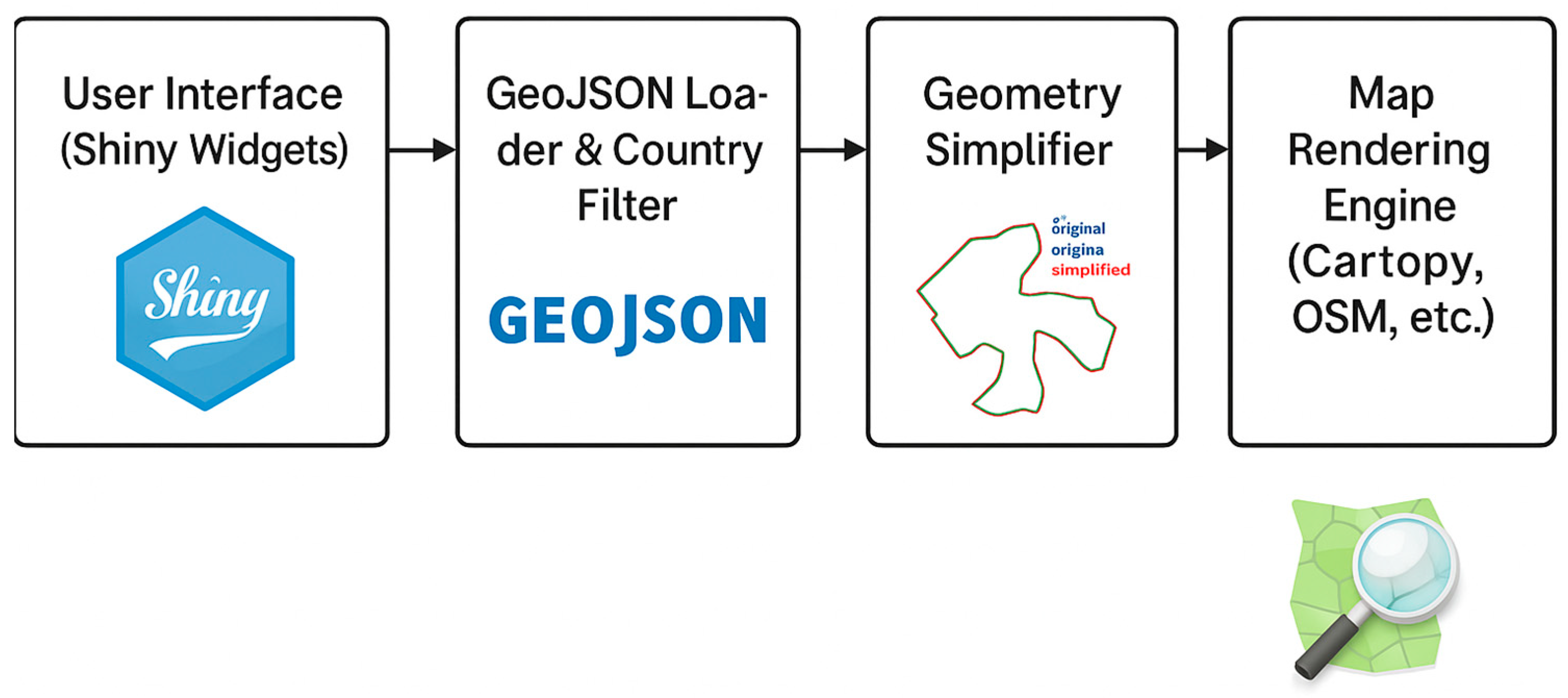
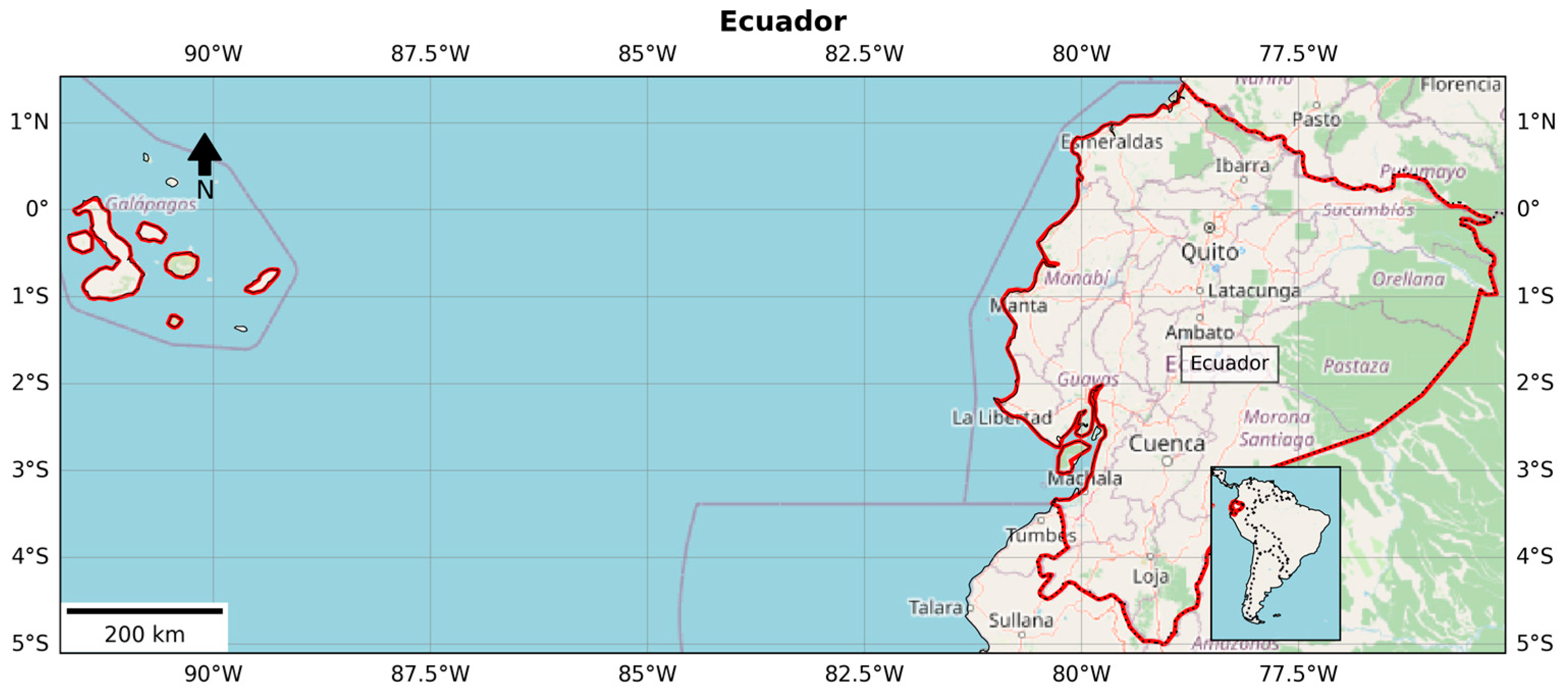
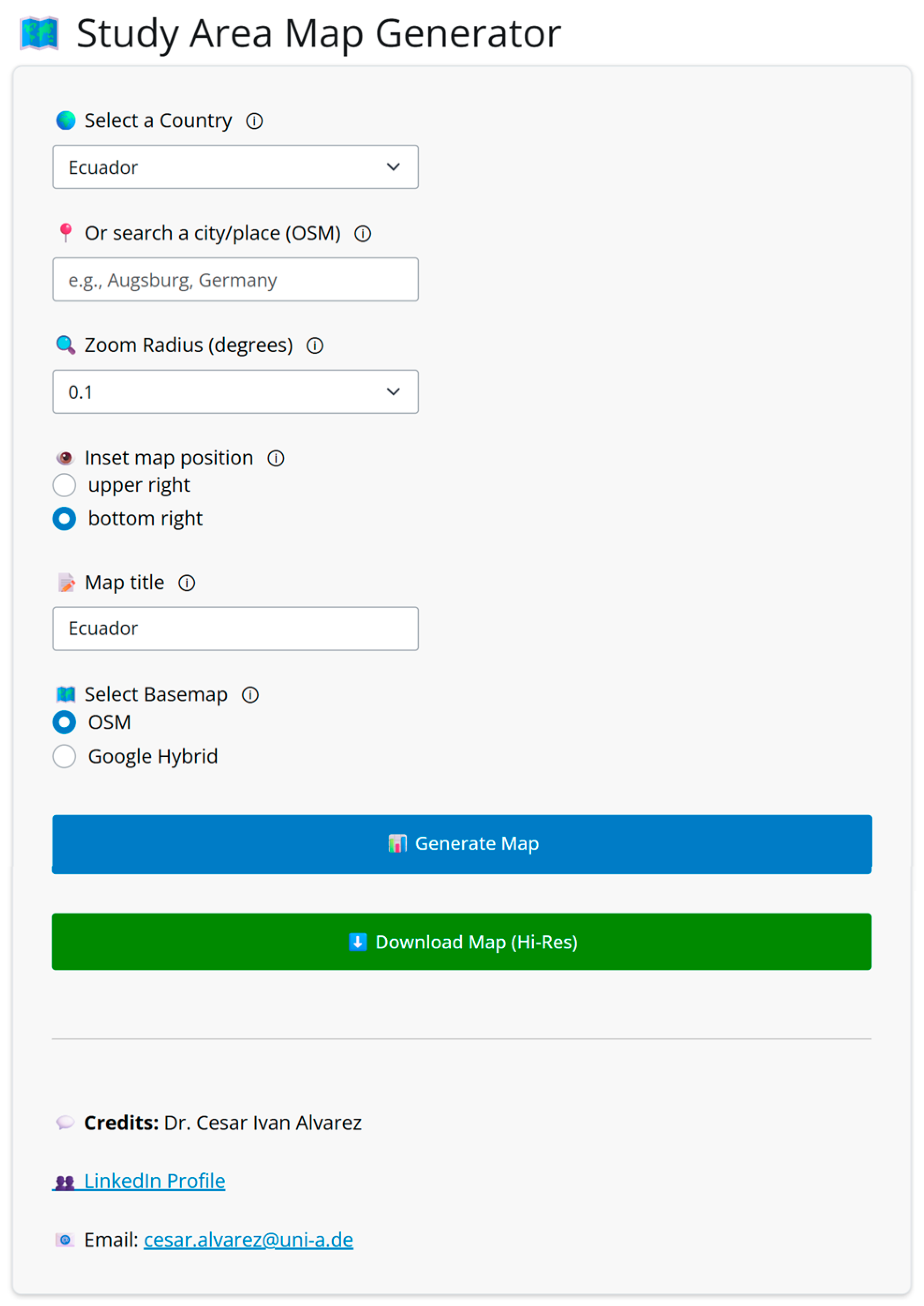
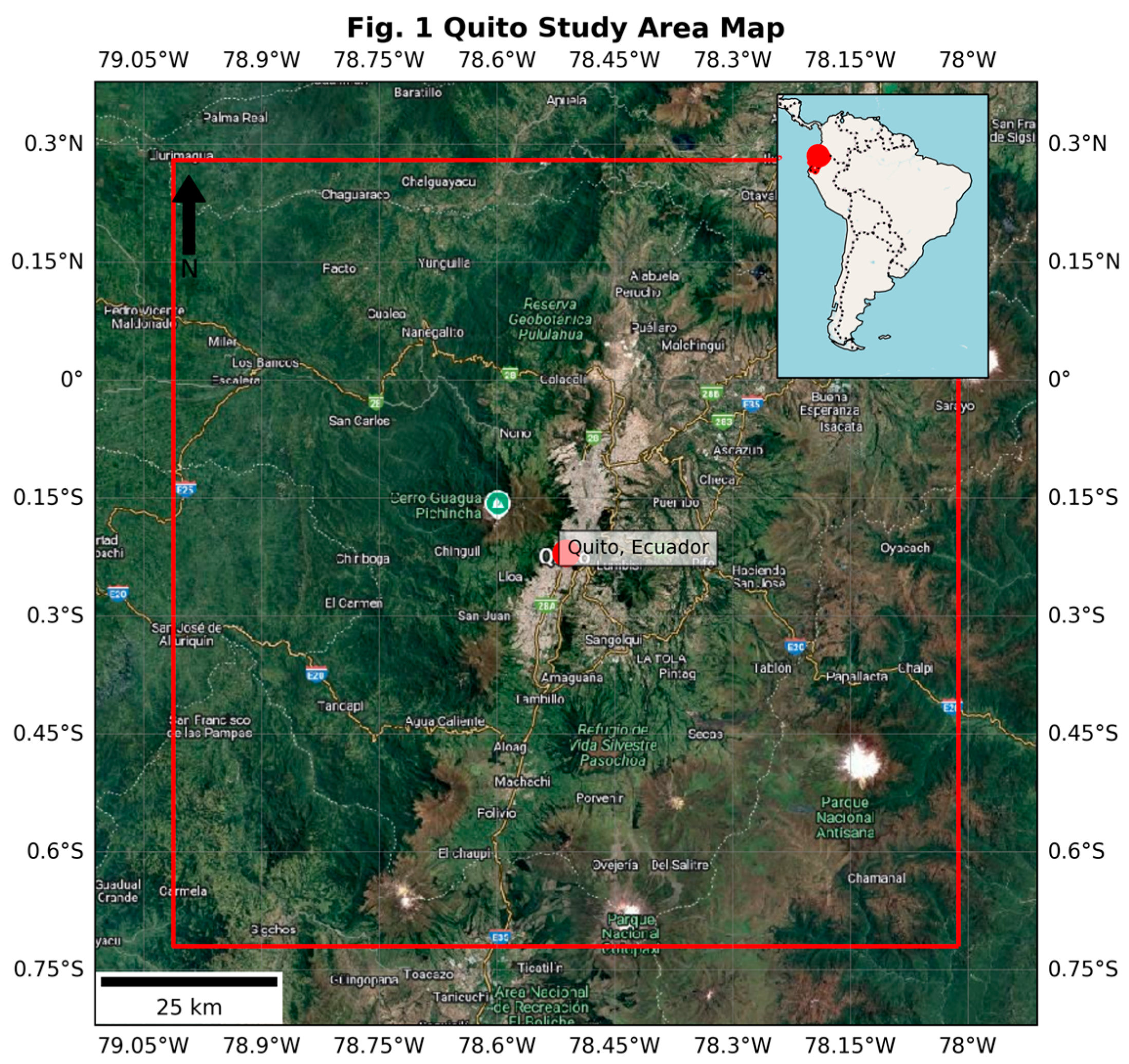
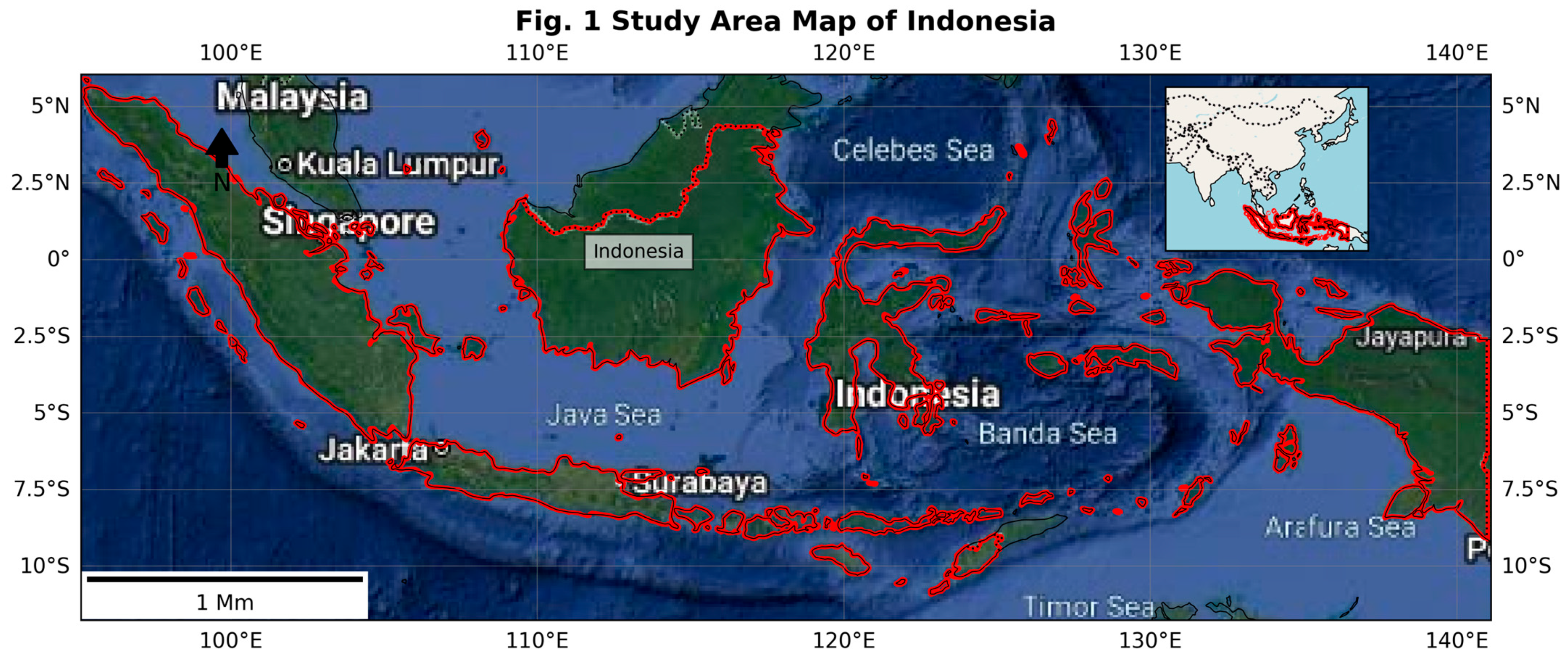
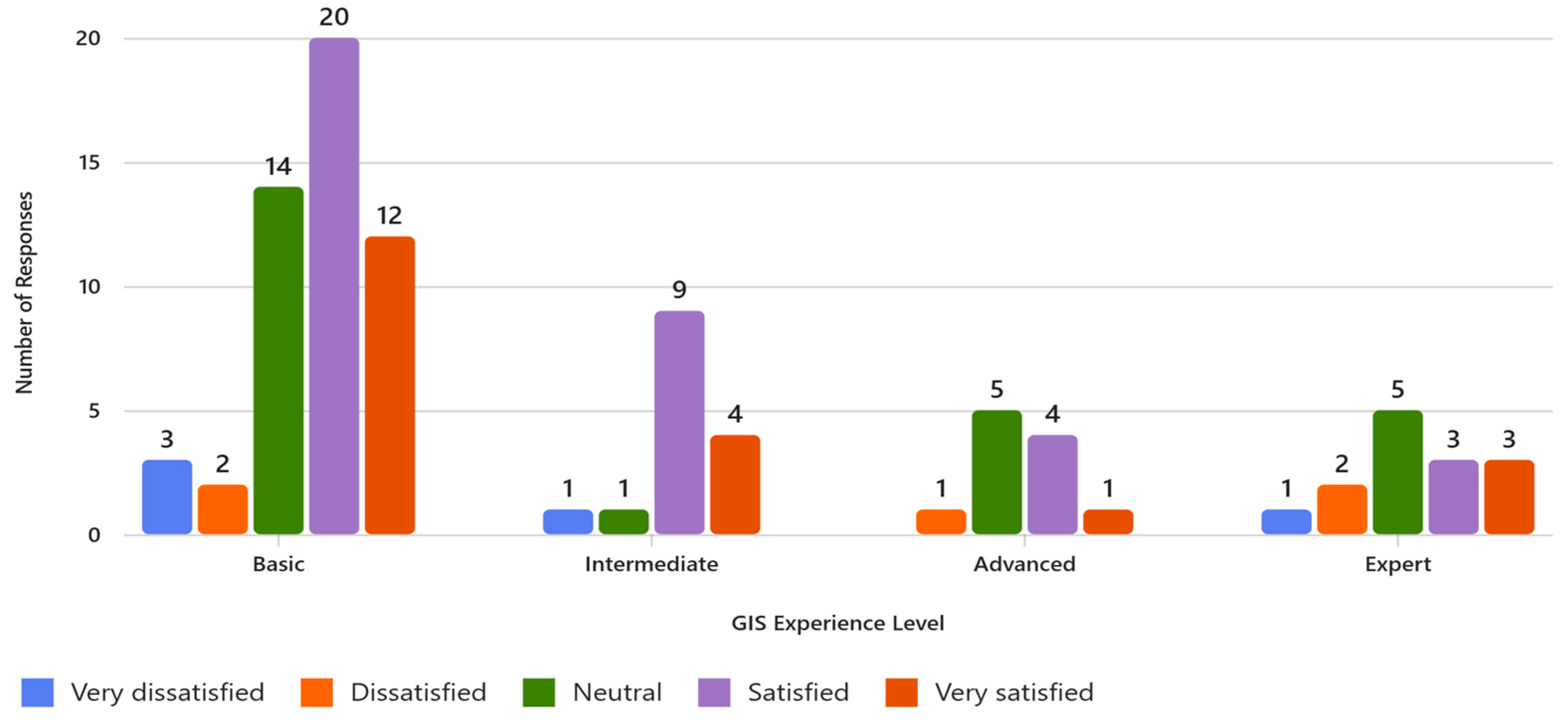
Disclaimer/Publisher’s Note: The statements, opinions and data contained in all publications are solely those of the individual author(s) and contributor(s) and not of MDPI and/or the editor(s). MDPI and/or the editor(s) disclaim responsibility for any injury to people or property resulting from any ideas, methods, instructions or products referred to in the content. |
© 2025 by the authors. Published by MDPI on behalf of the International Society for Photogrammetry and Remote Sensing. Licensee MDPI, Basel, Switzerland. This article is an open access article distributed under the terms and conditions of the Creative Commons Attribution (CC BY) license (https://creativecommons.org/licenses/by/4.0/).
Share and Cite
Alvarez, C.I.; Mollocana-Lara, J.G.; Sinde-González, I.; Teodoro, A.C. Study Area Map Generator: A Web-Based Shiny Application for Generating Country-Level Study Area Maps for Scientific Publications. ISPRS Int. J. Geo-Inf. 2025, 14, 387. https://doi.org/10.3390/ijgi14100387
Alvarez CI, Mollocana-Lara JG, Sinde-González I, Teodoro AC. Study Area Map Generator: A Web-Based Shiny Application for Generating Country-Level Study Area Maps for Scientific Publications. ISPRS International Journal of Geo-Information. 2025; 14(10):387. https://doi.org/10.3390/ijgi14100387
Chicago/Turabian StyleAlvarez, Cesar Ivan, Juan Gabriel Mollocana-Lara, Izar Sinde-González, and Ana Claudia Teodoro. 2025. "Study Area Map Generator: A Web-Based Shiny Application for Generating Country-Level Study Area Maps for Scientific Publications" ISPRS International Journal of Geo-Information 14, no. 10: 387. https://doi.org/10.3390/ijgi14100387
APA StyleAlvarez, C. I., Mollocana-Lara, J. G., Sinde-González, I., & Teodoro, A. C. (2025). Study Area Map Generator: A Web-Based Shiny Application for Generating Country-Level Study Area Maps for Scientific Publications. ISPRS International Journal of Geo-Information, 14(10), 387. https://doi.org/10.3390/ijgi14100387











